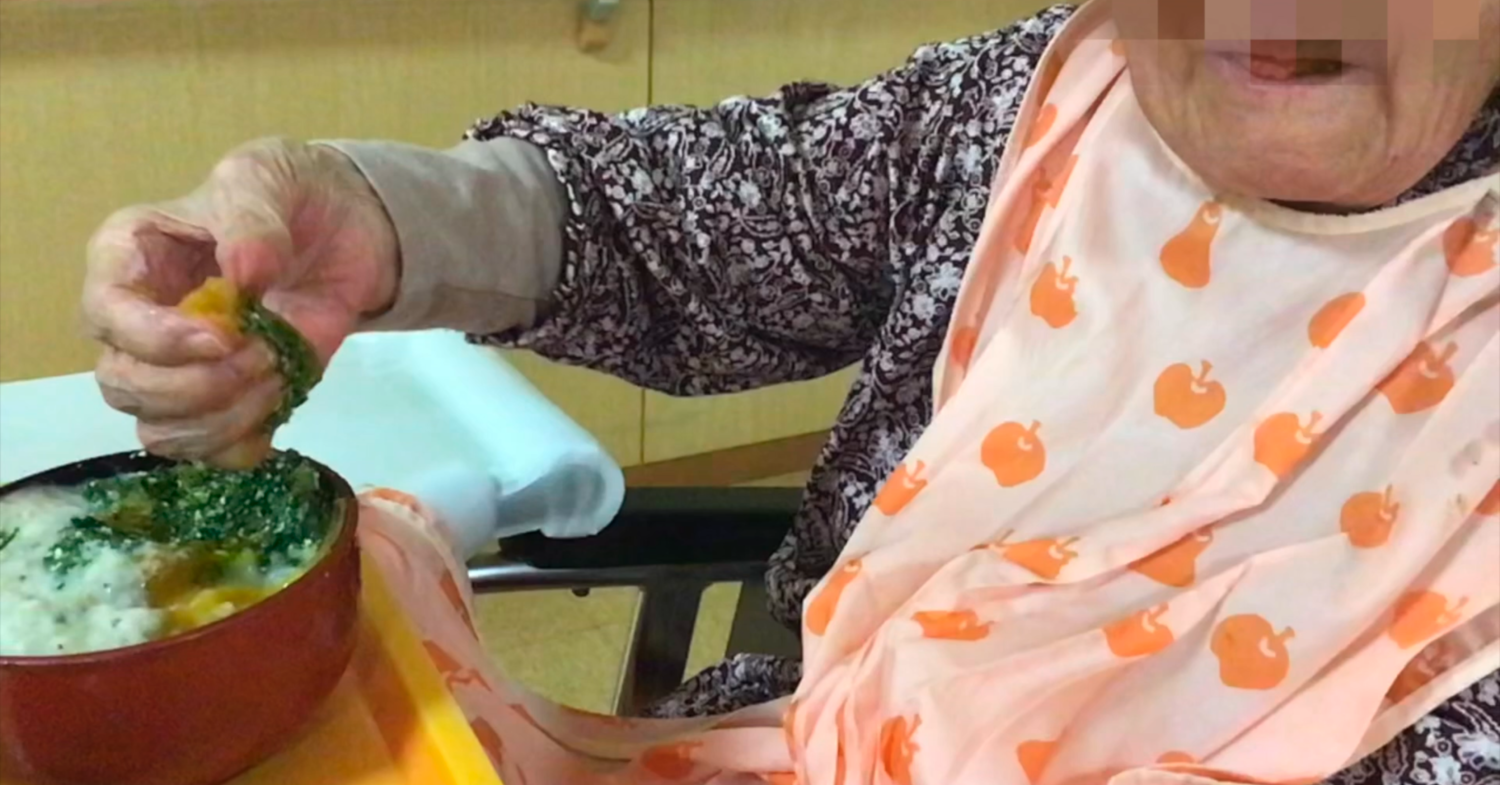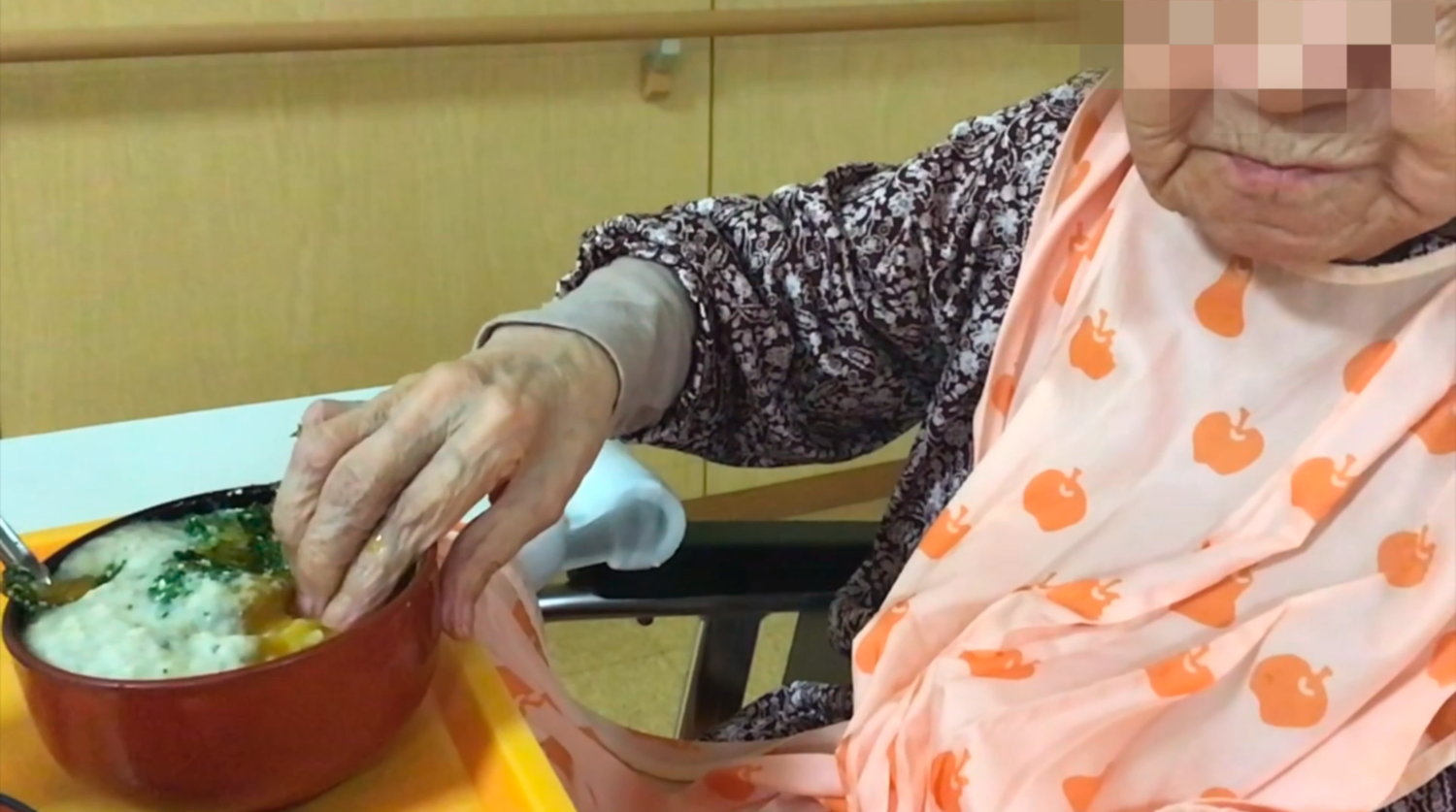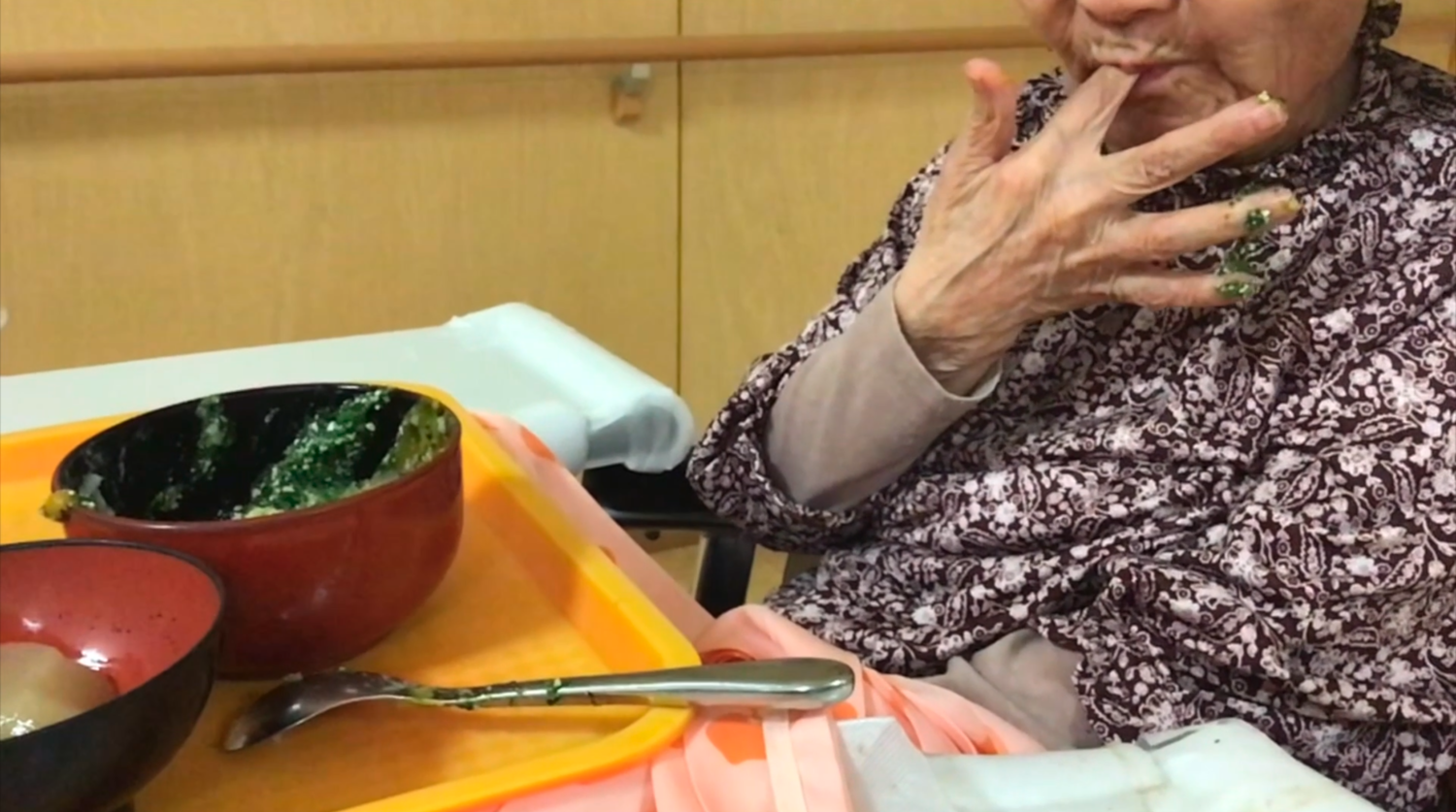
Hand-Eating
of the Elderly
English Translation: Aki Yahata
Various ways of eating for elderly people who need nursing care
When we observe elderly people who need nursing care at work in welfare facilities, we notice that there are several ways to “eat”. In most cases, they can use cutlery (chopsticks, spoons, etc.), but there are also cases that they have difficulty using cutlery due to reduced hand dexterity, agnosia (loss of recognition of the things), or apraxia (loss of awareness of how to use tools).
In such cases, we provide them with assistive devices (self-help tableware) to make it easier for them to eat, but if they have cognitive decline, it may be difficult for them to use self-help tableware. In our experience, in such cases, the elderly person is often fed by family members or caregivers (meal assistance).
However, in cases where the elderly have a strong desire to eat by themself, we have seen the elderly eat with their hands (eating-with-hands) or put their mouth directly on a bowl (e.g., a rice bowl) and sip the food as if drinking a drink. The sight of them grabbing food with their hands and spilling a lot of food made us feel “dirty” and “ill-behaved.” However, when I saw them trying to “eat” with their remaining physical and cognitive functions, I began to think that it was necessary to accept their appearance and support them to maintain safety.
Eating-with-hands as examined through experience in a nursing home
I have also introduced eating-with-hands in the magazine “Health Care Restaurant,” in which I am currently writing a series of articles (*1). I would like to introduce Ms. A, who was introduced there, here as well. (This is an addition to the article in Health Care Restaurant.)
Ms. A has severe dementia and can barely communicate. She repeatedly stood up and fell down, even though it was difficult for her to stand up due to her lower limb muscle weakness. Eventually, Ms. A became unable to stand up and moved around by crawling or squirming (kneeling) on the floor. The unit consulted me about Ms. A’s eating behavior.
“Ms. A doesn’t use a spoon or chopsticks. Should we help her eating because her uses hands?” When asked for more details by the caregivers, they say, ” She looks ill-behaved and dirty.”
Immediately after the consultation, I went to check on Ms. A’s eating habits. On that day, Ms. A refused even to come to the dining room and she was eating in her room (which is a single-person room). As mentioned above, because Ms. A has repeatedly fallen down, her room was a Japanese-style room with tatami mats instead of a bed. When eating in the room, a chabudai (Japanese small table) is set up for each time of meal, and finely chopped side dishes are served with the porridge. (the meal looks like dry curry in porridge.) Chopsticks and a spoon are provided, and when encouraging her to eat, staffs hand her the chopsticks and say, “Here are the chopsticks,” but she suddenly started eating with her hand. Her entire hand was covered with porridge, and it was no wonder that the nursing staffs felt that she was ill-behaved and dirty.
We tried to encourage her to use a spoon and started helping her to eat, but she would inevitably eat with her hand, and we found that it was smoother for her to eat with her hand than with assistance. We felt that Ms. A might not know how to use eating-utensils due to her dementia, so we continued to assist her eating for a while, while also watching over her hand-eating behavior at the right time as well. The food is not at a temperature that would cause scalding, and the other elderly are not concerned about how Ms. A eats. Also, she does not smear food on the table or other surfaces, and it is understood that she is eating with her hand instead of chopsticks or spoons. I thought it was “a little wrong” to force Ms. A, who uses her hand to eat deliciously, to use tools she does not know how to use because it was “bad manners.”
If she is willing, she can eat it with her hands!
As a conference was being held at the time, I suggested that as long as hand hygiene was being maintained before and after meals, it might be okay for her to eat meals with her hands. After various discussions, Ms.A’s hand-eating was approved by the staffs. Over time, Ms.A’s hand-eating began to change. Her eating way was getting similar to Indian’s hand-eating style what I have seen on TV. She no longer use her whole hand to eat, which used to be considered “dirty”.
We do not know the reason for the change in her eating style, but we assume that the change was gradual, as it is easier to use the fingertips rather than the whole palm.
The case of Ms. A led us to pay attention to the “hand-eating” of elderly once again. Although the number of cases is small and it is very rare to find a patient who eats everything by hand from the beginning to the end of a meal, I feel that there are three patterns of transition from eating with utensils to eating with hands.
The first is when the patient is unable to use eating utensils due to physical deterioration. In this case, the patient will often start by picking up the food with their hands while using the eating utensil. If the patient’s hand function is impaired, the caregiver can continue to encourage them to use self-help eating utensils by providing, but if the patient is unable to use self-help eating utensils, thay may switch to eating with hand. On the other hand, eating-with-hands due to vision loss is also seen. In this case, the individual can use common eating utensils, but looks that it would have been faster and easier for them to use their hands than to use eating utensils when groping for things. In both cases, the movements are often mixed. Eating with hands works as helping difficulty of use of utensils.
The second is a case in which the individual is unable to use eating utensils due to apraxia of action caused by dementia. The aforementioned Mrs. A is in this pattern. She cannot use chopsticks or spoons without recognizing them when she sees them. I feel that below is the flow of her eating process. “She reached for the thing in front of her and she could hold it in her hand. She thought it was food, so ate it.” In the case of the individual with cognitive decline, they may or may not be able to recognize food, and their reaction to food depends on the individual. Some of them put anything that touches their hands into their mouths (allotriophagy), so it is not always the case that they think “I don’t know how to eat, so I will eat with my hands”.
Third, there are cases where both physical and cognitive functions are impaired. In this case, the elderly have difficulty using eating-utensils due to the decline in physical function and is encouraged to use self-help eating utensils, but the elderly are unable to use self-help utensils because the self-help utensils are different from the eating-utensils in their memory. In addition, there is a pattern in which the patient does not recognize the eating utensil as eating tool even if it is put in front of them. I suspect that since they are able to recognize that what is in front of them is a meal, they think, “If I don’t have eating utensils, I will eat with my hands.

I consider Ms. B shown in the video to be Pattern 3 of the above. Ms. B entered our facility because her dementia became severe. When she first entered the facility, she was eating with eating utensils, but as her dementia progressed, she became unable to use them. At the same time, she began to exhibit an increasing number of behaviors that made us wonder if she was blind. Specifically, she did not follow her hands with her eyes, groped for objects, and did not look at me when I spoke to her.
In the video, Ms. B uses her fingertips well, and her eating style is similar to the “Eating Indian curry with hand” style of Ms. A introduced earlier. However, there was no gesture of pushing the food out with the thumb. Ms. B is also particularly good at using her three fingers to pick up and divide food. I sometimes see people eating food by hand as if pinching, but most of the time it is solid food that is easy to pick up (simmered dishes, grilled fish, etc.). Perhaps those who are good at skillful finger movement tend to approach the “Eating Indian curry with hand” style at the same time.

Another example is Ms. C, who ate by holding the food in the palm of her hand and bringing it to her mouth. This case was reminiscent of the way he tasted the food while cooking. This person changed from eating by hand to slurping directly from the food bowl, as she was able to slurp directly from the bowl when we placed one or two bites of the food in a small bowl.
The other person I would like to introduce is Ms. D. Ms. D is paralyzed on the right side of her body due to the aftereffects of cerebrovascular disease. At the time of her admission, she was unable to eat by herself, so the staff assisted her with her meals. She slowly started to eat by herself and began to use a spoon, but she was not able to do so well. Since Ms. D had only mild dementia, she seemed be ashamed to eating with her hands and would eat surreptitiously while looking around her. Ms. D had been eating by hand for a short period of time and is now able to eat her entire meals with a spoon. The case with Ms. D is considered to be Pattern 1 of the above. Even when she was eating by hand, more than 80% of the time, she ate with a spoon. When we saw her eating by hand, we thought it was a result of her appetite prevailing even though she felt it was bad manners. The strong desire to eat may have been the driving force behind her subsequent transition to eating with eating-utensils.
In the Japanese sense, eating with one’s hands is considered “bad manners.” My opinion is “eating with hands would be a one of good way.” The following is an excerpt from a health care restaurant that introduced the reasons for this.
There are two reasons why I believe that eating-with-handss is one of the best ways to eat.
The first reason is that there is a culture of “eating with hands” in the world. Living in Japan, people think it is “bad manners” to eat everything with hands. There are some foods that are eaten with hands, such as onigiri (rice balls) and bread, but eating grilled fish or stewed food with hands is considered bad manners. However, as you may have seen on TV or in other media, about 40% of the world’s people live in cultures where they eat with their hands. Differences in eating manners have developed due to differences in the characteristics of ingredients and cooking methods(*2), so perhaps eating-with-hands is not appropriate for Japanese food, but since eating with a knife and fork is common, I think that eating-with-hands is also fine.
The second reason is that I learned that by eating with their hands, they feel the texture of the food. I am sorry to say this is personal, but in a book(*3) that I referred to when I started weaning my own child, it says, “Babies learn to feel the size and firmness of food by grasping it with their hands, and learn how to move their fingers and how to use force to bring it to their mouths without crushing it. Grabbing food with the hands and bringing it to the mouth is a coordinated movement of the eyes, hands, and mouth. For example, when we grab a banana and put it in our mouth, we feel its touch, smell, texture, and taste. This means that we feel the banana with all five senses (summary).”
At first I thought that eating with hands was fine because “there is people in the world eat with their hands,” but after learning the second reason, I realized that for elderly people with dementia, eating with their hands may help them regain a sense of food that they had almost lost.
Eating-with-hands is one of the ways for the elderly to eat
After this experience, I now consider eating with one’s hands to be “one of the ways to eat” for the elderly. When we “eat with our hands,” the temperature and texture we receive from the food makes us imagine how the food feels in our mouth, such as the texture of the food on our tongue. The more information we receive than the sensations we receive when eating with chopsticks or a spoon may be a great stimulus for people with dementia.
We would like to continue to enjoy and feel how hand-eating affects the elderly.
*2 Osaka Kyoiku University Three major food manners
http://www.osaka-kyoiku.ac.jp/~ioku/foodsite/hashi/sandaisyokusahou.html
*3 Nobuko Nakagawa, The New Knowledge of Breastfeeding and Baby Food. Smart child rearing starts from the mouth. 2010, Shogakukan.
Profile

Natsuyo Yokoyama
Registered Dietitian at Special Nursing Home for the Elderly, Buna no Sato, Myoshin Fukushikai Social Welfare Corporation.
Licensed as a Registered Dietitian in 2000, she worked in the Nutrition Support Team at Ibaraki Southwest Medical Center Hospital, JA Ibaraki Koseiren before assuming her current position in 2009.





Leave a
Comment